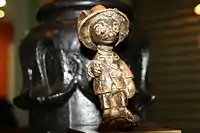Ratoncito Pérez
El Ratoncito Pérez or Ratón Pérez (literally translated into English as Perez mouse or Perez the Mouse) is a figure popular in Spanish and Hispanic American cultures, similar to the tooth fairy, originating in Madrid in 1894. As is traditional in some English-speaking countries, when a child loses a tooth it is customary for him or her to place it under the pillow, so that Ratoncito Pérez will exchange it for a gift. The tradition is almost universal in Spanish cultures, but takes different forms in different areas. He is known as "Ratoncito Pérez" in Spanish speaking countries, with the exception of some regions of Mexico, Guatemala, Peru and Chile, where he is called "el Ratón de los Dientes" (The Tooth Mouse), and in Argentina, Venezuela, Uruguay and Colombia, he is known simply as "El Ratón Pérez".

Similarly in the Philippines, some Christian ethnic groups have the same allusion of a rat when they lose the teeth. However, unlike in the hispanic countries, the rat is not named.
The Ratoncito Pérez has been used in by Colgate marketing in Venezuela, stars in the 2006 Argentine movie El Ratón Pérez, and appeared in the tale of the Vain Little Mouse.
Origin

A mouse named Ratón Pérez or "ratonpérez" or "ratompérez" first appeared in "Cuentos, oraciones, adivinanzas y refranes populares" (1877), by Fernán Caballero, the pen name of Cecilia Böhl de Faber y Larrea,[1] in "La hormiguita" as her gentle and timid husband, as well as the husband of "La Ratita Presumida" (The Vain Little Mouse). This character would later inspire Luis Coloma, who would make him part of the Spanish traditional folklore by turning him into a sort of Tooth Fairy.[2]
In 1894, Coloma was contracted to write a story for Alfonso XIII, who had just lost his tooth at the age of 8.[3] Coloma's story follows Ratoncito Pérez who lived with his family in a box of cookies in Madrid, but frequently ran away from home through the pipes of the city, and into the bedrooms of children who had lost their teeth. The story details how Ratoncito Pérez cunningly misleads any cats in the vicinity who may be lurking, and includes his interaction with King Buby (Queen Maria Christina's nickname for Alfonso XIII).
The city council of Madrid paid tribute to Ratoncito Pérez with a commemorative plaque outside the warehouse where the mouse was said to have lived. The plaque reads: "Here lived, in a box of cookies, Ratoncito Pérez, according to the story that the father Coloma wrote for the young King Alfonso XIII." Ratoncito Pérez thus became the first fictional character honored with a plaque by the Madrid City Council. Coloma's original manuscript, with his signature and a dedication to King Alfonso XIII, is now located in the vault of the Royal Palace Library.[4]
Adaptations
_pg_1.jpg.webp)
Coloma's original story has been retold and adapted in various formats since it was published in the early 1900s. One such retelling was by Lady Moreton entitled "Perez the Mouse", which she published in 1915 and attributed to Coloma.[4]
In 2006, the story was filmed under the title El Ratón Pérez (or Perez, the mouse of your dreams), directed by Juan Pablo Buscarini.[5] The Ratoncito Pérez has been used in Colgate marketing in Venezuela,[6] and the character appeared earlier in the tale of the Vain Little Mouse.
Other adaptations include El ratoncito Pérez by Olga Lecaye (1999), La mágica historia del Ratoncito Pérez by Fidel del Castillo (1996), ¡S.O.S., salvad al ratoncito Pérez! by Eduardo Galán (1995), and Ratoncito Pérez, en Vuelo de Cometas by Vicenta Fernández Martín (1999).[4]
Raton Perez makes an appearance in DreamWorks Animation's film Rise of the Guardians, when one of the Tooth Fairy's mini fairies finds him at works and tackles him before the Tooth Fairy stops the fight
Handy Manny episode "Julieta's Tooth" makes mention of "Mr. Perez" among other nicknames for the "tooth Mouse" to take her tooth after Manny retrieves it from the sink trap.
In episode 5 of the Spanish television series El Internado, Un cadáver en La Laguna, The Ratoncito Pérez appears in order to take a tooth from Paula.
See also
- Tooth Fairy
- Hammaspeikko – Finnish tooth troll
- Spanish folklore
References
- http://www.biblioteca.org.ar/libros/153695.pdf
- "CVC. Ratón Pérez". Retrieved 10 December 2020.
He wrote works that were very well received by his readers: Pequeñeces, Boy, Jeromín... and children's stories, like Pelusa and Ratón Pérez, which were dedicated to his friends and pupils. Luis Coloma appears to be the first author to write a story featuring our famous mouse.
- "Casa del Ratón Pérez". Retrieved 10 December 2020.
- "CVC. Ratón Pérez". Retrieved 10 December 2020.
The manuscript of Father Coloma, with his signature and a dedication to King Alfonso XIII, is bound in green leather with a gold brooch and gilt edges. It remains in the vault of the Royal Palace Library.
- "El Ratón Pérez". Retrieved 10 December 2020.
- "Producto.com". Archived from the original on October 20, 2010.
Further reading
- Lainez, Rene Colato (2010). The Tooth Fairy Meets El Raton Perez. Illustrated by Tom Lintern. ISBN 978-1-58246-296-7.
- Luis Coloma, Ratón Pérez (2000), with illustrations by Cruz Pintor
- José Manuel Pedrosa, The Secret History of the Ratón Pérez (2005)
External links
- Ratón Pérez by Luis Coloma – original manuscript, provided by Project Gutenberg
- Ratoncito Pérez – The Tooth Fairy of Spain – History and English translation